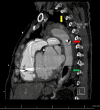Aortic Dissection From an Intra-aortic Balloon Pump: A Dangerous Complication to Keep in Mind
- PMID: 37332456
- PMCID: PMC10273174
- DOI: 10.7759/cureus.39122
Aortic Dissection From an Intra-aortic Balloon Pump: A Dangerous Complication to Keep in Mind
Abstract
Despite the benefits of the intra-aortic balloon pump (IABP) being a subject of debate, it remains a widely available and easy-to-use mechanical circulatory support device. Nonetheless, its use is not exempt from complications. Aortic dissection from IABP is an infrequent but deathly complication. We describe a case in which early recognition of the condition led to control through an endovascular approach. A 57-year-old male was admitted for acute decompensated heart failure requiring intravenous inotropic agents. While undergoing assessment for a heart transplant, he developed cardiogenic shock requiring initiation of mechanical circulatory support with an IABP. A few hours after device implantation, the patient developed acute tearing chest pain and was found to have an acute dissection in the descending thoracic aorta. Prompt liaison with the endovascular team led to a thoracic endovascular aortic repair to control the extent of the lesion.
Keywords: aortic dissection management; intra-aortic balloon pump; intra-aortic balloon pump (iabp); mechanical circulatory assistant devices; thoracic aortic dissection; thoracic endovascular aortic repair.
Copyright © 2023, Mijares-Rojas et al.
Conflict of interest statement
The authors have declared that no competing interests exist.
Figures





References
-
- Intra-aortic balloon pump: current evidence & future perspectives. Huu AL, Shum-Tim D. Future Cardiol. 2018;14:319–328. - PubMed
-
- Intraaortic balloon pump in cardiogenic shock complicating acute myocardial infarction: long-term 6-year outcome of the randomized IABP-SHOCK II trial. Thiele H, Zeymer U, Thelemann N, et al. Circulation. 2019;139:395–403. - PubMed
-
- Contemporary management of cardiogenic shock: a scientific statement from the American Heart Association. van Diepen S, Katz JN, Albert NM, et al. Circulation. 2017;136:0–68. - PubMed
-
- Mechanical circulatory support with Impella versus intra-aortic balloon pump or medical treatment in cardiogenic shock-a critical appraisal of current data. Wernly B, Seelmaier C, Leistner D, et al. Clin Res Cardiol. 2019;108:1249–1257. - PubMed
Publication types
LinkOut - more resources
Full Text Sources
